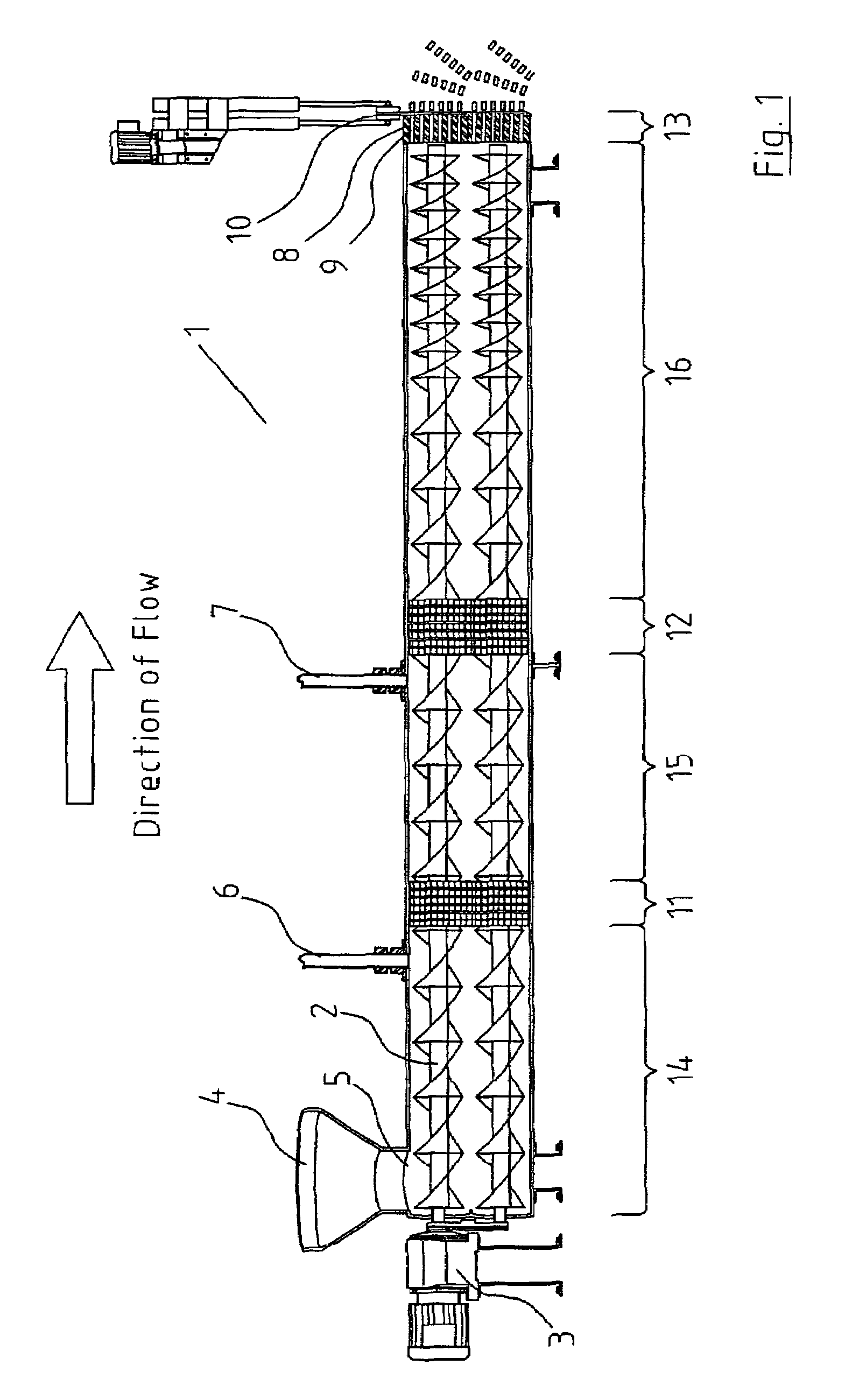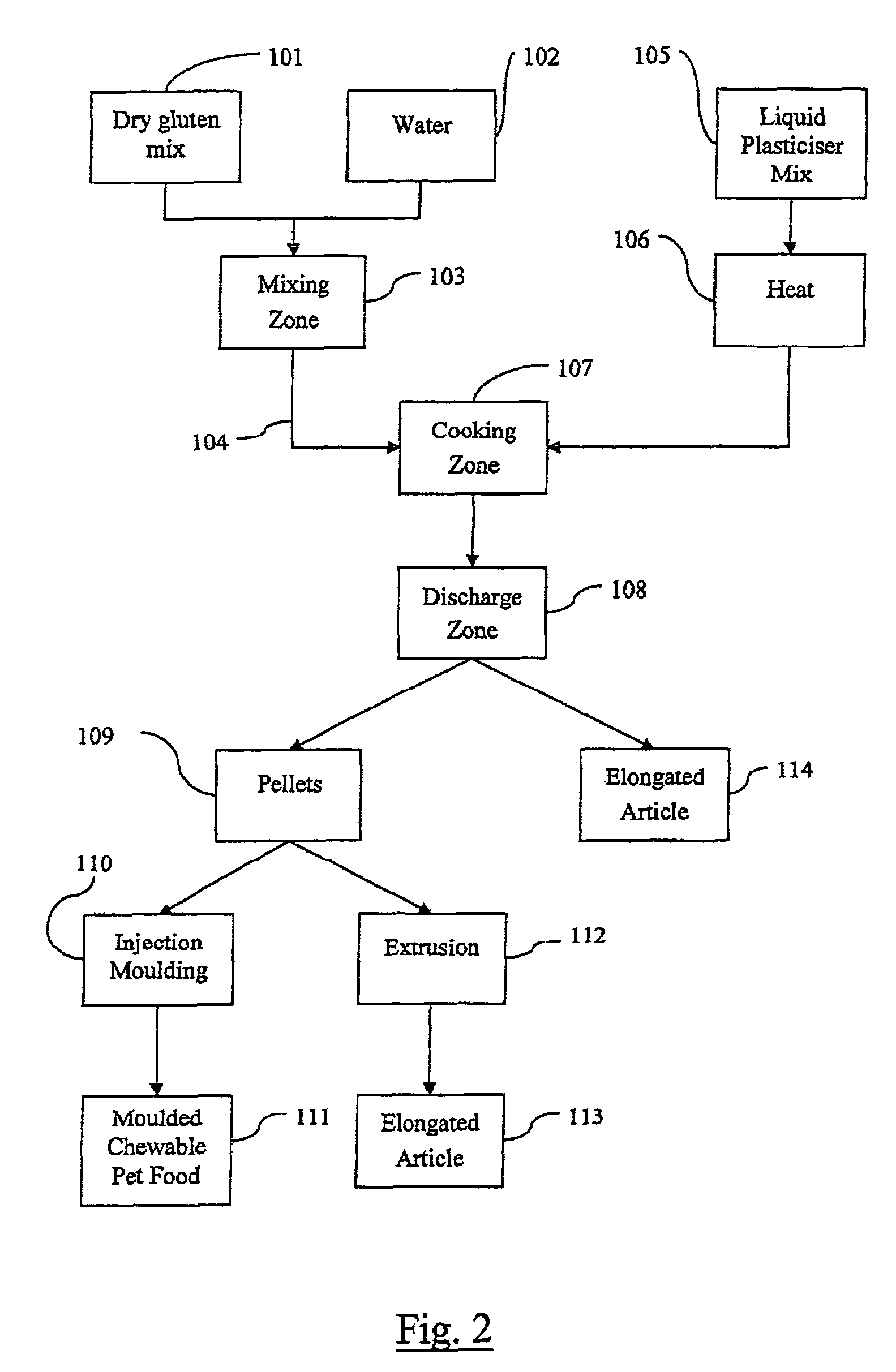Process for preparing a chewable pet food
a pet food and processing technology, applied in the field of extrudable products, can solve the problems of unsuitable products for chewing, wheat gluten processing difficulties, and control of processing flowability, and achieve the effects of less complex shapes, faster and cheaper process, and better finish
- Summary
- Abstract
- Description
- Claims
- Application Information
AI Technical Summary
Benefits of technology
Problems solved by technology
Method used
Image
Examples
example 1
[0059]The composition and chewable pet food were prepared as follows and according to the quantities as outlined in Table 1.
[0060]A dry mix was prepared by mixing the wheat gluten, cellulose fibre, chicken digest, and calcium stearate together. The dry mix was fed into an extruder having an inlet temperature of 40° C. and fed along a transfer zone. Water was then mixed with the dry wheat gluten mix in the mixing zone to provide the moist wheat gluten mix. The paddles in the mixing zone were set at 30° offset. The moist wheat gluten mix was transferred along the second transfer zone of the extruder which had a temperature of 50° C. A liquid plasticizer mix was prepared by mixing together the glycerine, peppermint oil and colorings. The liquid plasticizer mix was then heated to a temperature of 55° C. before feeding it into the extruder where it was mixed with the moist wheat gluten mix in the cooking zone to form the gluten plasticizer composition. The paddles in the cooking zone wer...
example 2
[0063]The composition and chewable pet food were prepared as follows and according to the quantities as outlined in Table 2.
[0064]A dry mix was prepared by mixing the wheat gluten, cellulose fibre, chicken digest, monoglycerides of edible fatty acids, sodium tripolyphosphate, calcium stearate and potassium chloride together. The dry mix was fed into an extruder having an inlet temperature of 45° C. and fed along a transfer zone. Water was then mixed with the dry wheat gluten mix in the mixing zone to provide the moist wheat gluten mix. The paddles in the mixing zone were set at 30° offset. The moist wheat gluten mix was transferred along the second transfer zone of the extruder which had a temperature of 55° C. A liquid plasticizer mix was prepared by mixing together the glycerine, parsley oil and colorings. The liquid plasticizer mix was then heated to a temperature of 55° C. before feeding it into the extruder where it was mixed with the moist wheat gluten mix in the cooking zone ...
example 3
[0066]The composition and chewable pet food were prepared as follows and according to the quantities as outlined in Table 3.
[0067]A dry mix was prepared by mixing the wheat gluten, sodium tripolyphosphate and potassium chloride. The dry mix was fed into an extruder having an inlet temperature of 35° C. and fed along the transfer zone. Water was then mixed with the dry wheat gluten mix in the mixing zone to provide the moist wheat gluten mix. The paddles in the mixing zone were set at 30° offset. The moist wheat gluten mix was transferred along the second transfer zone of the extruder which had a temperature of 45° C. A liquid plasticizer mix was prepared by mixing together the glycerine, parsley oil and colorings. The liquid plasticizer mix was then heated to a temperature of 50° C. before feeding it into the extruder where it was mixed with the moist wheat gluten mix in the cooking zone to form the gluten plasticizer composition. The paddles in the cooking zone were set at 60° offs...
PUM
 Login to View More
Login to View More Abstract
Description
Claims
Application Information
 Login to View More
Login to View More - R&D
- Intellectual Property
- Life Sciences
- Materials
- Tech Scout
- Unparalleled Data Quality
- Higher Quality Content
- 60% Fewer Hallucinations
Browse by: Latest US Patents, China's latest patents, Technical Efficacy Thesaurus, Application Domain, Technology Topic, Popular Technical Reports.
© 2025 PatSnap. All rights reserved.Legal|Privacy policy|Modern Slavery Act Transparency Statement|Sitemap|About US| Contact US: help@patsnap.com



